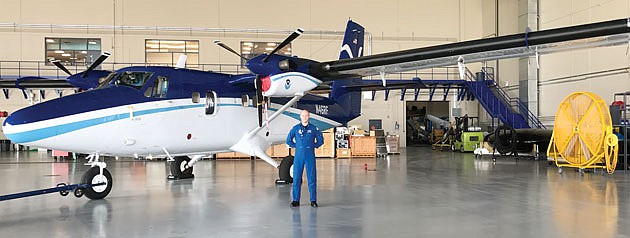- November 27, 2024
-
-
Loading

Loading

By John Haughey | Contributing Writer
Two months after the National Oceanic and Atmospheric Administration's Aircraft Operations Center moved into its new headquarters at Lakeland Linder Regional Airport, there are unopened boxes in empty cubicles in hush-quiet offices above a cavernous hangar, where a lone technician wheels a toolbox about, tending to the Lockheed WP-3D Orion, Gulfstream G-4 Jet and De Havilland Twin Otter parked there.
On a recent August afternoon, glare from the sun-blazed tarmac radiates into the aircraft center, where Lt. j.g. Billy Bonner is the only NOAA officer in sight. “This is only the second week that everybody is here,” he said.
On any given day, half the AOC's 20 pilots, 90 scientists and technicians, and nine aircraft could be tracking tropical depressions in the Caribbean, scanning seas off Hawaii for whale pods, monitoring aircraft maintenance in Indianapolis or flying for the National Geodetic Survey. As the AOC's public affairs officer, Bonner guides tours, regaling visitors with the derring-do of NOAA's heralded “Hurricane Hunters.” These are the fearless pilots and crews who fly P-3 Orions into the eyes of storms to provide data meteorologists use to issue alerts that save lives.
“It's an 8-4, 9-5 type of job,” he deadpans, “with a little bit of flying through hurricanes dished in.”
Standing before an Orion dubbed Kermit, its illustrations drawn by Muppets creator Jim Henson himself, Bonner points to fuselage logos logging 100 hurricanes and two typhoons Kermit has flown into since 1976. Kermit's sister P-3, Miss Piggy, is also part of the fleet.
Hurricane Hunters are the stars, but flying into the face of a storm is not NOAA's only mission. Bonner, for instance, pilots a utilitarian Twin Otter that flies “low and slow” for the National Geodetic Survey's GRAV-D program, a $39 million project to collect “vertical datum” that documents how “gravity changes from one point to another.”
The story behind Lakeland Linder becoming the home of the Hurricane Hunters dates back to February 2016. That's when the Air Force informed NOAA it was moving eight KC-135 Stratotanker jets into Hangar 5 at MacDill Air Force Base in Tampa — which the AOC had occupied since 1993. Looking for a new home, NOAA officials limited its search for a new home to within 50 miles MacDill. It came down to Lakeland Linder or St. Pete-Clearwater International Airport.
Lakeland Linder Airport Manager Eugene Conrad said the city promised NOAA an AOC made to the agency's specifications. To do so, it diverted funds from an $8.5 million cargo jet maintenance construction project to renovate the 88,000-square-foot Airside Center into a 106,000-square-foot structure with a 58,000-square-foot hangar. The city won the bid in December, and the AOC was ready in May.
“What was impressive was our ability to produce a 106,000-square-foot facility in five-and-a-half months,” Conrad said. “That speaks volumes about our ability to deliver. It raises the bar for us.”
NOAA will pay Lakeland Linder $6.8 million to lease the AOC for five years with an optional $5.8 million five-year extension. The contract boosts the airport's annual revenue by 15%.
Under Conrad, Lakeland Linder has invested more than $100 million, primarily in state and federal grants, in a litany of projects. The list includes a new air traffic control tower, taxiways, ramps and a firefighting station equipped to handle aviation fires. The 1,700-acre airport has 75 tenants, with about 1,100 employees.
“NOAA wouldn't be here” without these amenities, Conrad says, but what intrigued the agency was the presence of aviation schools — Central Florida Aerospace Academy, International Aero Academy, Polk State College's Aerospace Sciences. “We are building our own labor force,” he adds.
Not only that, but airport and economic development officials hope NOAA is a catalyst for more opportunities. “There are companies looking at us because NOAA is here and because of what we were able to do to get them here,” Conrad says. “There is interest — and we have 42 acres ready for development.”
What's good for the airport is also good for NOAA and its hunters.
“It's brand new — they built it just for us, to our specifications,” Bonner says. “It suits our needs much better than MacDill.”